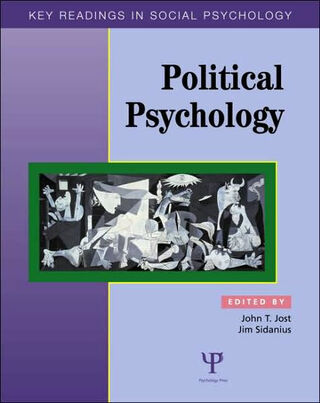Psychology
A Tribute to Jim Sidanius
Celebrating one of the most influential social scientists.
Posted July 15, 2021 Reviewed by Vanessa Lancaster
Key points
- Jim Sidanius' work, including the Social Dominance Theory, explained manifestations of ideology, prejudice, exploitation, and group conflict.
- Jim Sidanius' quantitative analysis of public opinion data used sophisticated techniques to shed light on ideological functioning.
- Sidanius was also a dedicated mentor who has inspired and nurtured many talented young scholars.
By John Jost, Ph.D.
Social psychology has never seen anyone like Jim Sidanius (1945-2021) and may never see anyone like him again. As a teenager in New York City, he was beaten brutally by police officers for the crime of being a young black male hanging out with a white girl in the early 1960s. No doubt that experience contributed to his youthful radicalism: he was a civil rights agitator within a few years. When his friends began turning up dead, Jim fled, first to Africa and then to Europe. He was searching for an egalitarian paradise and never found it, even in Sweden. Instead, he found social science, and he became one of its very best practitioners for the next forty years.
Jim became one of the most influential social, personality, and political psychologists of his generation. His work was exemplary on theoretical, methodological, and empirical grounds; it was distinctive and paradigm-shifting. He was singularly courageous in crossing levels of analysis, from sociology and political science to psychology and anthropology and even evolutionary biology.
Social Dominance Theory (SDT) sought to integrate evidence from all of these diverse areas. The book Jim wrote with Felicia Pratto on Social Dominance: An Intergroup Theory of Social Hierarchy and Oppression is, quite simply, a tour de force (Sidanius & Pratto, 2001). It clearly and persuasively laid out the case for their highly distinctive approach to understanding the most disturbing manifestations of ideology, prejudice, exploitation, and intergroup conflict.
Jim’s analysis of public opinion data used sophisticated statistical techniques to shed light on ideological functioning, often turning up surprising or paradoxical findings. His work had clear societal and political implications, and he was never shy about facing and debating them. His work was provocative and controversial, but the quality was so good that honest brokers had to take it seriously.
Jim was involved in lively debates concerning (a) the cognitive-motivational basis of political ideology; (b) the role of racial resentment in conservative opposition to affirmative action; and (c) SDT in relation to other theories of intergroup relations, such as Social Identity Theory (SIT) and System Justification Theory (SJT). One need not agree with every word that Jim ever wrote or said to be impressed by the seriousness of his scholarship and his ability to intellectually engage with others on matters that are central to the mission of social science.
Jim started by addressing a classic issue in political psychology—also discussed by Gordon Allport, T. W. Adorno, Milton Rokeach, Hans Eysenck, Phil Tetlock, and others—about whether liberals and conservatives differ in terms of dogmatism, mental rigidity, intolerance of ambiguity, cognitive complexity, and related variables (Sidanius, 1985). He used structural equation modeling and other statistical techniques that were at the time quite innovative to investigate linear and quadratic effects of psychological variables on left-right political orientation in Europe and the U.S.
Jim proposed context theory to (a) distinguish between economic and cultural dimensions of conservatism and their implications for attitudes about race, gender, etc., and (b) propose that ideological extremists might have more rather than less complex and sophisticated attitudes on certain issues, insofar as political deviation requires self-confidence and other cognitive-motivational skills and abilities (Sidanius, 1988).
The next phase of Jim’s career focused on the eclectic, multi-disciplinary development of SDT, which emerged from recognizing that many different ideologies existed to justify diverse types of social and economic inequalities. The endorsement of these other ideologies tended to be inter-correlated. For example, favorable attitudes toward capitalism are predictive of racism, and so on (Sidanius & Pratto, 1993). Jim argued that there must be individual differences that could have a genetic component underlying attitudes about equality and inequality.
Jim and his collaborators showed that this individual difference variable could be measured as Social Dominance Orientation (SDO), which predicted career choices and other consequential behaviors, as well as social and political attitudes (Sidanius & Pratto, 2001). Another focus was on the degree to which attitudes supporting inequality are consensually shared by members of advantaged and disadvantaged groups in society.
A third central area to which Jim contributed focused on the question of whether conservative opposition to affirmative action was “principled” or whether it instead reflected a form of subtle (or modern) racism. This started largely as a debate with Paul Sniderman and Thomas Piazza, with Jim and his colleagues demonstrating that education increased rather than decreased the strength of the association between conservative ideology and racial antipathy, suggesting that its more sophisticated practitioners wielded conservatism as a way of justifying racial disparities and opposing societal remedies (Federico & Sidanius, 2002; Sidanius, Pratto, & Bobo, 1996).
A book that Jim edited along with David Sears and Larry Bobo (based on a conference held at UCLA) brought together a diverse group of psychologists, sociologists, and political scientists to weigh in on the determinants of opinions about affirmative action and racial attitudes in general (Sears, Sidanius, & Bobo, 2000). Jim also spearheaded an important longitudinal study of college students, resulting in several significant publications (e.g., Sidanius, Levin, Van Laar, & Sears, 2008). Jim contributed as much as anyone in social psychology to understanding diversity issues in general and attitudes about race-based affirmative action in particular.
In some ways, the last chapter in Jim’s career was the most impressive one of all. After moving from UCLA to Harvard University in 2006, Jim’s research focused even more squarely than before on the foundations of intergroup behavior in evolutionary biology. Jim and his collaborators tackled the multidimensional structure of SDO, the role of emotions such as fear and empathy in intergroup dynamics, and specific cognitive and perceptual mechanisms—including hypodescendant categorization—that give rise to prejudice and discrimination. In a fascinating article that was published in Proceedings of the National Academy of Sciences, Jim and his colleagues used multi-level modeling (linking micro and macro levels of analysis) to demonstrate that country-level means on SDO were positively correlated with gender inequality and violent conflict in society and negatively correlated with civil liberties and democratic functioning. The authors concluded that “societal inequality is reflected in people’s minds as dominance motives that underpin ideologies and actions that ultimately sustain group-based hierarchy” (Kunst et al., 2017).
In terms of his scientific reputation and professional visibility, Jim was at the top of the field for a very long time. He received numerous awards and grants from the National Science Foundation (NSF) and Russell Sage Foundation. He served on the editorial boards of several journals, including Psychological Review, Political Psychology, Social Justice Research, International Journal of Conflict and Violence, and the Du Bois Review. He was a Fellow of the Association for Psychological Science (APS) and the American Academy of Arts and Sciences (AAAS) and served as Vice President of the International Society of Political Psychology (ISPP). He received numerous honors and awards, including the Harold Lasswell Award for Outstanding Scientific Accomplishment in Political Psychology (2006), Society for Personality and Social Psychology Career Contribution Award (2013), the Society of Experimental Social Psychology Distinguished Scientist Award (2020), and the American Psychological Association Distinguished Scientific Award for the Applications of Psychology (2021).
I consider myself extremely lucky to have become friends with Jim, first in California and later on the East Coast. To me, he was an ideal senior colleague, a mentor from a distance, someone who took an early interest in me and my work, kept tabs on me, supported my career, and influenced my thinking immensely. He reached out to me, provided encouragement and valuable advice, and always made it clear that we could work together on shared interests and problems without agreeing on every detail. Jim was tenacious about pursuing ideas, but he was a warm and gentle person committed to fostering intellectual values of open-mindedness, respect, tolerance, diversity, and creativity.

We published a book together on Political Psychology and an article or two as well. We commiserated about the anxiety of public speaking, from which we both suffered. We laughed at the extreme, overwrought dismissiveness of some of our worst critics. I loved Jim Sidanius, even when I disagreed with him about, say, the origins of gender differences or the inevitability of group-based hegemony, or the immutability of human nature. There was a profound, hard-earned, ineradicable pessimism in his thinking about society that I could never quite square with his enthusiastic, upbeat, optimistic personality. Still, mainly I remember how much fun it was to argue with him, how warm and sincere he was, and how contagious and all-encompassing his smile was.
Jim was a role model in so many different ways: he saw social science as an urgent undertaking, a way of making the world a better place; he took ideas seriously and treated people with respect and dignity even in the heat of scholarly battle; he valued empirical evidence above all else, although I am not sure it really changed his mind on major questions; and he relentlessly pushed himself and others to excel. For the rest of my career, I will cherish every animated, inspiring conversation I ever had with Jim at conferences, universities, bars, restaurants, over the telephone, and even on a podcast called “Tatter,” on which we were both interviewed by Michael Sargent.
Jim Sidanius was one of the most important and influential social scientists in the world. For more than four decades, Jim’s work was consistently groundbreaking, careful, serious, and important. He always led by example and by upholding rigorous scientific and ethical standards. In so doing, he consistently brought out the best in people. He was also a dedicated mentor who has inspired and nurtured many talented young scholars who have gone on to have distinguished careers. We will miss him deeply.
References
Federico, C. M., & Sidanius, J. (2002). Racism, ideology, and affirmative action revisited: the antecedents and consequences of" principled objections" to affirmative action. Journal of Personality and Social Psychology, 82, 488-502.
Jost, J.T., & Sidanius, J. (Eds.) (2004). Political psychology: Key readings. New York: Psychology Press/Taylor & Francis.
Kunst, J. R., Fischer, R., Sidanius, J., & Thomsen, L. (2017). Preferences for group dominance track and mediate the effects of macro-level social inequality and violence across societies. Proceedings of the National Academy of Sciences, 114(21), 5407-5412.
Sears, D. O., Sidanius, J., & Bobo, L. (Eds.). (2000). Racialized politics: The debate about racism in America. University of Chicago Press.
Sidanius, J. (1985). Cognitive functioning and sociopolitical ideology revisited. Political Psychology, 6, 637-661.
Sidanius, J. (1988). Political sophistication and political deviance: A structural equation examination of context theory. Journal of Personality and Social Psychology, 55, 37–51.
Sidanius, J., Levin, S., Van Laar, C., & Sears, D. O. (2008). The diversity challenge: Social identity and intergroup relations on the college campus. Russell Sage Foundation.
Sidanius, J., & Pratto, F. (1993). Racism and support of free-market capitalism: A cross-cultural analysis. Political Psychology, 14, 381-401.
Sidanius, J., & Pratto, F. (2001). Social dominance: An intergroup theory of social hierarchy and oppression. Cambridge University Press.
Sidanius, J., Pratto, F., & Bobo, L. (1996). Racism, conservatism, affirmative action, and intellectual sophistication: A matter of principled conservatism or group dominance? Journal of Personality and Social Psychology, 70, 476-490.




